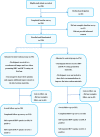A randomized controlled trial enhancing viral hepatitis testing in primary care via digital crowdsourced intervention
- PMID: 35853995
- PMCID: PMC9296450
- DOI: 10.1038/s41746-022-00645-2
A randomized controlled trial enhancing viral hepatitis testing in primary care via digital crowdsourced intervention
Abstract
Despite the availability of hepatitis B virus (HBV) and hepatitis C virus (HCV) testing in primary care, testing rates in China remain low. Social media is an inexpensive means of disseminating information and could facilitate hepatitis testing promotion. We evaluated the capacity of digitally crowdsourced materials to promote HBV/HCV testing uptake via a randomized controlled trial (identifier: ChiCTR1900025771), which enrolled 750 Chinese primary care patients. We randomized patients (1:1) to receive crowdsourced HBV/HCV promotion materials through social media or facility-based care without promotional materials for four weeks. Exposure to all intervention materials was associated with increased odds of HBV (aOR = 1.79, 95% CI: 1.09-3.00) and HCV (aOR = 1.95, 95% CI: 1.29-2.99) testing compared to facility-based care. There was a significant reduction in hepatitis stigma among intervention group participants (HBV slope: -0.15, p < 0.05; and HCV slope: -0.13, p < 0.05). Digitally crowdsourced promotion messages could enhance hepatitis testing uptake and should be considered in hepatitis reduction strategies.Trial registration: Chinese Clinical Trial Registry (ChiCTR1900025771) on September 9, 2019. Available from: http://www.chictr.org.cn/showproj.aspx?proj=42788.
© 2022. The Author(s).
Conflict of interest statement
P.C. is a staff member of the World Health Organization; the author alone is responsible for the views expressed in this publication, and they do not necessarily represent the decisions or policies of the World Health Organization. W.K. Seto received speaker’s fees from AstraZeneca and Mylan, is an advisory board member of Abbott, is an advisory board member and received speaker’s fees from AbbVie, and is an advisory board member, received speaker’s fees and researching funding from Gilead Sciences. The remaining authors declare no competing interests.
Figures



Similar articles
-
Crowdsourcing to promote hepatitis C testing and linkage-to-care in China: a randomized controlled trial protocol.BMC Public Health. 2020 Jul 2;20(1):1048. doi: 10.1186/s12889-020-09152-z. BMC Public Health. 2020. PMID: 32615951 Free PMC article. Clinical Trial.
-
A crowdsourced intervention to promote hepatitis B and C testing among men who have sex with men in China: study protocol for a nationwide online randomized controlled trial.BMC Infect Dis. 2018 Sep 29;18(1):489. doi: 10.1186/s12879-018-3403-3. BMC Infect Dis. 2018. PMID: 30268114 Free PMC article. Clinical Trial.
-
Digital, Crowdsourced, Multilevel Intervention to Promote HIV Testing Among Men Who Have Sex With Men: Cluster Randomized Controlled Trial.J Med Internet Res. 2023 Oct 30;25:e46890. doi: 10.2196/46890. J Med Internet Res. 2023. PMID: 37902831 Free PMC article. Clinical Trial.
-
Comparing Ways to Increase Hepatitis B and C Screening among Asian Americans [Internet].Washington (DC): Patient-Centered Outcomes Research Institute (PCORI); 2020 Feb. Washington (DC): Patient-Centered Outcomes Research Institute (PCORI); 2020 Feb. PMID: 39808005 Free Books & Documents. Review.
-
Coinfection of Schistosoma Species with Hepatitis B or Hepatitis C Viruses.Adv Parasitol. 2016;91:111-231. doi: 10.1016/bs.apar.2015.12.003. Epub 2016 Feb 5. Adv Parasitol. 2016. PMID: 27015949 Review.
Cited by
-
Shared-care models are highly effective and cost-effective for managing chronic hepatitis B in China: reinterpreting the primary care and specialty divide.Lancet Reg Health West Pac. 2023 Mar 20;35:100737. doi: 10.1016/j.lanwpc.2023.100737. eCollection 2023 Jun. Lancet Reg Health West Pac. 2023. PMID: 37424676 Free PMC article.
-
Marketing strategies for promoting workplace hepatitis B and C virus testing: a cross-sectional study using correspondence analysis in Japan.Front Public Health. 2025 Mar 6;13:1522850. doi: 10.3389/fpubh.2025.1522850. eCollection 2025. Front Public Health. 2025. PMID: 40115348 Free PMC article.
-
Synergistic interaction between pay-it-forward incentives and recreational drug use on hepatitis B virus and hepatitis C virus testing among men who have sex with men in China.Sex Transm Infect. 2024 Jul 26;100(5):302-309. doi: 10.1136/sextrans-2024-056150. Sex Transm Infect. 2024. PMID: 38862237 Free PMC article.
-
Effectiveness and implementation of decentralized, community- and primary care-based strategies in promoting hepatitis B testing uptake: a systematic review and meta-analysis.EClinicalMedicine. 2024 Sep 12;76:102818. doi: 10.1016/j.eclinm.2024.102818. eCollection 2024 Oct. EClinicalMedicine. 2024. PMID: 39309722 Free PMC article.
-
Video based educational intervention in waiting area to improve awareness about health screening among patients visiting family medicine clinics.BMC Health Serv Res. 2024 Jul 16;24(1):818. doi: 10.1186/s12913-024-11143-4. BMC Health Serv Res. 2024. PMID: 39014436 Free PMC article.
References
-
- World Health Organization. World Hepatitis Day 2019: Invest in eliminating hepatitis. Available from: https://www.who.int/campaigns/world-hepatitis-day/2019. Accessed 3rd September, 2021. (2020).
-
- World Health Organization. Hepatitis in China. Available from: https://www.who.int/china/health-topics/hepatitis. Accessed January 13th, 2022.
Grants and funding
LinkOut - more resources
Full Text Sources

